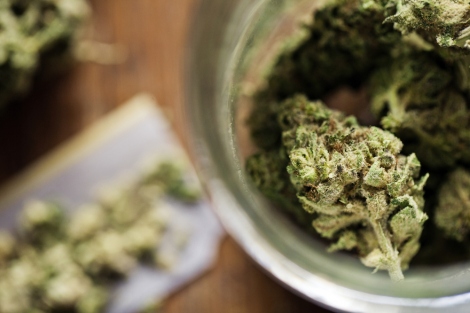Marijuana Should Be Packaged, Regulated Following Tobacco Control Best Practices
UCSF Study Finds Current Cannabis Regulations Inadequate to Protect Public Health
 California already has the nation’s largest medical marijuana market, and this year is expected to have the world’s largest recreational market. With enormous potential to influence policy, the state should take an assertive approach to cannabis labeling, packaging and product formulation, according to a new UC San Francisco study.
California already has the nation’s largest medical marijuana market, and this year is expected to have the world’s largest recreational market. With enormous potential to influence policy, the state should take an assertive approach to cannabis labeling, packaging and product formulation, according to a new UC San Francisco study.
The analysis found that requiring plain packaging and large warning labels, reducing visual appeal to minors, and putting strict limits on the potency of cannabis products would better protect public health over business interests.
The research, which draws upon the best practices of tobacco control, serves as a roadmap to improve new marijuana regulations in California.
The paper is published in the Journal of Psychoactive Drugs.
The findings are important, the authors said, because California policy could set the tone for regulating the nascent cannabis industry nationwide and help prevent the type of harm seen due to widespread tobacco use before public health policies were enacted to counter that industry.
“There’s an opportunity to do cannabis policy well, to apply lessons from regulating other products,” said first author Daniel G. Orenstein, JD, MPH, a UCSF postdoctoral fellow at the UCSF Center for Tobacco Control Research and Education, and the Philip R. Lee Institute for Health Policy Studies at UCSF.
“If effective control methods had been in place in the early era of mass tobacco commercialization, immense harm could have been prevented,” Orenstein said. “By applying lessons from tobacco control best practices now, in the early period of cannabis commercialization, we may avoid repeating that unfortunate history.”
In November 2017, the California Department of Public Health – which oversees cannabis manufacturing, packaging and labeling – issued initial medical and adult use regulations.
The new UCSF analysis assessed those regulations using evidence-based best practices from tobacco control. It focused on manufactured cannabis, which includes concentrates, extracts, edibles, tinctures, topicals, and other products.
The recommendations include:
- Requiring larger and more comprehensive labels, rotating messages, and graphic warnings to reduce the appeal of marijuana to minors, while better informing adult consumers;
- Requiring plain packaging – no logos or branding;
- Eliminating packaging that appeals to children or imitates non-cannabis products;
- Prohibiting flavorings in nonedible products;
- Prohibiting product formulations that may increase health risks;
- Prohibiting additives that promote addictiveness.
“The current six point warning labels are hard to see, much less read,” said senior author Stanton A. Glantz, PhD, UCSF professor of medicine and director of the UCSF Center for Tobacco Control Research and Prevention. “The political power of the emerging cannabis industry will only make it harder to regulate cannabis in a way that prioritizes public health.”
“California has a world-class tobacco control media campaign that takes on the tobacco industry and strong laws to protect bystanders from secondhand smoke,” Glantz said. “The state should deploy these strategies to minimize marijuana use in addition to implementing tobacco control best practices to cannabis warning labels, packaging, and product formulations because they are likely to be effective for cannabis.”
A January 2017 report issued by the National Academies of Sciences, Engineering, and Medicine, which provides nonpartisan guidance for national decision-makers, found substantial evidence that cannabis is effective for treating chronic pain, nausea and vomiting, and in reducing spasticity symptoms in multiple sclerosis, but also found clear risks for pregnant women and youth. It found substantial evidence of an association between cannabis use and the risk of motor vehicle crashes, as well as of lower birth weight after maternal use, more frequent chronic bronchitis episodes, and the development of schizophrenia or other psychoses. The report recommended prioritizing cannabis research – clinically and in health policy, health economics, public health and public safety – especially in at-risk and under-researched populations, such as children and youth, older populations, pregnant women and heavy users.
The research was supported in part by the National Institute of Drug Abuse grant DA-043950.
UC San Francisco (UCSF) is a leading university dedicated to promoting health worldwide through advanced biomedical research, graduate-level education in the life sciences and health professions, and excellence in patient care. It includes top ranked graduate schools of dentistry, medicine, nursing and pharmacy; a graduate division with nationally renowned programs in basic, biomedical, transitional and population sciences; and a preeminent biomedical research enterprise. It also includes UCSF Health, which comprises three top-ranked hospitals, UCSF Medical Center and UCSF Benioff Children's Hospitals in San Francisco and Oakland, and other partner and affiliated hospitals and healthcare providers throughout the Bay Area.